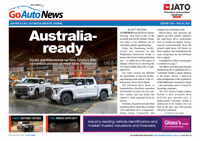 1 Oct 2009
1 Oct 2009
PORSCHE’S first ever sedan and at launch, its most expensive car in Australia took the form of its Panamera grand tourer.
It was built on a new platform that measured 4970mm long, 1418mm high and 1931mm wide, and featured a galvanised shell using a high-strength steel or aluminium. The bonnet, doors, tailgate and quarter panels were aluminium.
With three model choices, the Panamera opened with the rear-wheel-drive S, propelled by a naturally aspirated 294kW/500Nm 4.8-litre V8 with a six-speed manual gearbox (or the PDK seven-speed dual-clutch transmission as a no-cost option).
This engine and the PDK transmission were shared by the next model up the ladder, the all-wheel-drive Panamera 4S (the six-speed manual was not available on 4S), which also got the same coil-spring suspension with aluminium front double-wishbone front and multi-link rear axle.
The premium Panamera was the Turbo, with a twin-turbocharged version of the 4.8-litre V8 with outputs of 368kW/700Nm and the PDK seven-speed transmission as standard.
The Turbo featured Porsche Traction Management and adaptive air suspension with a load-levelling system and adjustable ride height (also optional for S and 4S). The Turbo also has Porsche’s Dynamic Chassis Control, which included a differential lock.
A Sports Chrono option across the range enhanced transmission shift points, and in the case of the turbo, provided another 70Nm of torque for brief periods. This system included Porsche Launch Control which shaved acceleration times by 0.2sec.
Impressive performance figures came as standard. The S with PDK could reach 100km/h in a claimed 5.6 seconds (5.4 with the Sports Chrono package), the 4S in 5.0 seconds (or 4.8 seconds with the Sports Chrono package). The S’s top speed was 283km/h. (4S: 282km/h), while the combined fuel consumption figure was 10.8L/100km (4S: 11.1) and CO2 emissions at 253g/km (4S: 260).
The flagship Turbo blasted to 100km/h in 4.2 seconds (4.0 seconds with Sports Chrono), 160km/h in 9.0 seconds, and 200km/h in 13.9, with a top speed of 300km/h. Its combined fuel consumption and CO2 ratings were 12.2L/100km and 286g/km.
Front brakes across the range were six-piston aluminium monobloc callipers working on ventilated, grooved and cross-drilled discs. Rear brakes comprised four-piston aluminium monobloc callipers grabbing ventilated and grooved discs.
The Panamera Turbo’s brake discs were upsised to390mm front and 350mm rear, compared with the 360mm front and 330mm rears on the S and 4S.
Other standard features included idle-stop (on PDK-equipped models only), a three-way electronic damper control system, stability control, engine drag torque control, anti-lock brakes, brake assist, trailer stabilisation function and hill-holder.
In July 2010 an entry-level variant hit Australian showrooms, powered by a 3.6-litre V6 feeding 220kW and 400Nm to the (rear or optionally all) wheels via a standard PDK transmission. Claimed average fuel consumption for the V6 was under 10L/100km with 213g/km of CO2 emitted by the rear-drive version and 220 grams by the all-wheel drive version.
A new hybrid powertrain was announced for Porsche’s Panamera in mid-2013 that saw a new variant added to its sports sedan line-up. The plug-in Panamera can travel up to 36 kilometres on electricity alone before its petrol engine kicks in to alleviate range-anxiety and can accelerate from zero to 100km/h in just 5.5 seconds.


















